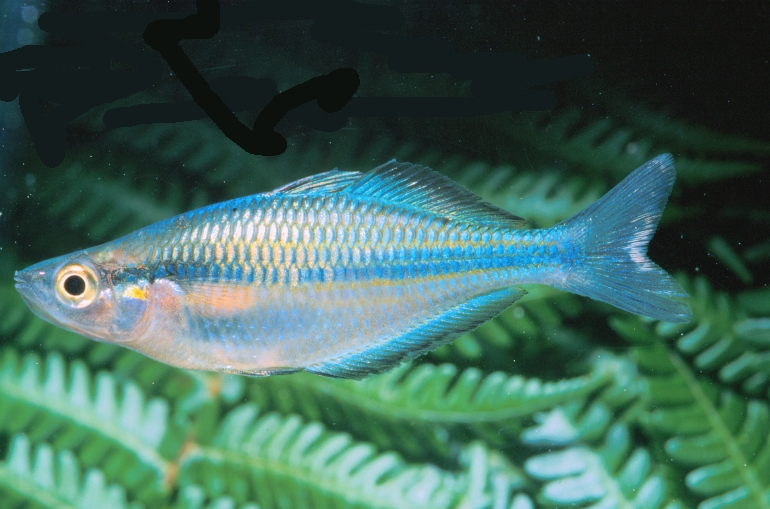|
 |
M. mubiensis (Ofake Creek) - photo© Gerald Allen |
Allen, 1996
Mubi Rainbowfish
Species Summary
Melanotaenia mubiensis are blue-green on the upper half of head and back, frequently with golden sheen anteriorly, lower side whitish. Dark blue midlateral band extending from rear edge of eye to base of caudal fin, about one scale row wide anteriorly and two scales wide on caudal peduncle. 6-7 pale orange stripes between each horizontal scale row on upper half of body. Yellowish stripe, one scale wide, immediately below dark midlateral band, from pectoral fin base to level of middle anal rays. Pupil sized orange spot on upper part of operculum. Iris of eye golden-yellow. First dorsal fin pale green or bluish. Second dorsal and anal fins dusky blackish, except bluish basally. Caudal fin bluish to translucent, upper and lower edge narrowly dusky. Pelvis fins translucent with dusky anterior edge. Pectoral fins mainly translucent. Female colouration generally less intense and all fins mainly translucent or bluish. Males are generally deeper bodied and have more elongated, somewhat pointed shape posteriorly on the soft dorsal and anal fin rays.
Melanotaenia mubiensis is most closely related to Melanotaenia lacustris from Lake Kutubu. Large adults of the two species have very similar colouration. However, they differ in several features, including body depth, eye size, and modal fin ray counts. Adults of M. mubiensis are much more slender than those of M. lacustris; the four largest male types of M. mubiensis had an average depth as percent of the SL of 38.4 compared to an average of 47.2 for M. lacustris. The eye diameter of M. lacustris is larger than the snout length, but in M. mubiensis it is shorter or equal to the snout length. Although the two species have overlapping counts for dorsal, anal, and pectoral fin rays, there are significant modal differences. M. mubiensis most frequently has 14 or 15 dorsal rays, 21 or 22 anal rays, and 14 pectoral rays compared to usual counts of 12 or 13, 18 or 19, and 15 respectively for M. lacustris. M. mubiensis is also similar in general appearance to M. monticola, which occurs in the middle Kikori and adjacent Purari River system. The two species have been collected together. Besides differing in colour pattern they also have differences in soft dorsal and anal fin rays; M. monticola has 15 to 17 dorsal rays and 18 to 21 (usually 19 or 20) anal rays.
Distribution & Habitat
Melanotaenia mubiensis was collected from a relatively small section of the middle Kikori drainage system, spanning a distance of approximately 20 km, between elevations of about 380 and 400 metres above mean sea level. All sites were tributaries of the Mubi River, one of the primary mountain tributaries of the Kikori, and the outlet for Lake Kutubu, which lies approximately 70 km farther upstream from the collecting sites. The habitat consists of narrow, crystal clear streams in closed-canopy forest, flowing through limestone hills. The holotype was collected from a spectacular series of sinkholes linked by short tunnels to the main channel of the Mubi River.
The Lake Kutubu-Digimu-Mubi sub-basin comprises Lake Kutubu, the Soro-Digimu River (which drains the lake) and the Mubi River of which the Digimu River is a tributary. The Digimu River flows west then south through the deep and narrow elongate valleys between the Iwa and Kube Kabe ranges to join the Mubi River. The Mubi River arises in fine dendritic tributaries and swamplands to the east of the lake, flowing southeast and southwest in steps before flowing northwest around the Kuba Kabe Range where it receives the waters of the Digimu River before flowing out via Wassi Falls into the Kikori River.
Remarks
This species is named mubiensis with reference to the general locality where the type specimens were collected. Currently no live specimens have been collected for the aquarium hobby.
Literature
Allen G.R. (1996). Two new species of rainbowfishes (Melanotaenia: Melanotaeniidae), from the Kikori River system, Papua New Guinea. Revue française d'Aquariologie 23 (1-2): 9-16.
Adrian R. Tappin
Updated September, 2016



|
|

